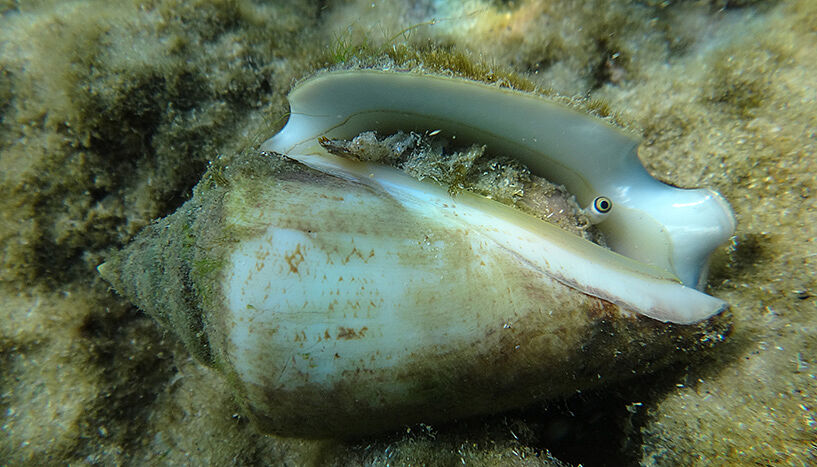Profound ecological change in the Eastern Mediterranean Sea
03. November 2021
A tropical conch (Conomurex persicus) in shallow water off the Israeli Mediterranean coast (© Jan Steger)
Distinct ecological niches: Tropical species profoundly alter ecosystem functioning in the Eastern Mediterranean Sea – with unknown consequences.
Assemblages of tropical non-indigenous species in the Eastern Mediterranean have biological traits that markedly differ from those of native biological communities. This was shown by an international team of scientists led by Jan Steger from the Department of Palaeontology at the University of Vienna. As a consequence – and because of the progressive collapse of Mediterranean species – shallow-water ecosystems in the region have undergone profound change. The study has been published in Global Ecology and Biogeography.
The Eastern Mediterranean Sea is subject to dramatic ecological change – while native species increasingly disappear, tropical non-indigenous species introduced through the Suez Canal, so-called Lessepsian species, thrive due to seawater warming. Their increase, however, does not seem to be related to a direct displacement of native species, but rather to the occupation of ‘empty niches’, according to a recent study published in the journal Global Ecology and Biogeography.
“To understand how the increase of tropical species may affect the native fauna and the functioning of ecosystems, we need to compare their biological traits – such as lifestyle and feeding habits – to those of the native fauna”, says Jan Steger, doctoral student and first author of the study.
To successfully establish, non-indigenous species must not only cope with the local environmental conditions, but also with potential competition with native species. The latter may be achieved by utilizing resources – such as habitats or food – more efficiently, which can result in an eventual displacement of resident species with similar ecological roles; however, such a process entails only little change in the functioning of the invaded ecosystem. “For a long time, this was a frequently stated hypothesis. Recent studies on fishes in the Eastern Mediterranean, however, suggested the opposite, namely that Lessepsian species are successful invaders if their biological traits markedly differ from those of the native fauna, that is, if they occupy ‘empty niches’ in the recipient ecosystem and thus escape competition”, explains Steger.
Unknown invasion history
A major unknown in the interpretation of observed patterns has so far been the long history of the invasion: while tropical species have started to enter the Mediterranean already shortly after the opening of the Suez Canal in 1869, systematic data on the composition of the native fauna have become available only much more recently. “What we observe today is the outcome of a decades-long massive ecological transformation, however, we did not know how it came about”, says Paolo Albano, principal investigator of the Austrian Science Fund (FWF) project that led to these results. “It seemed possible that we only observe functional differences between the native and tropical components of biological communities because Mediterranean species with similar ecological roles have previously been displaced without anyone noticing. Finding out if this was indeed the case is crucial to understand the impacts of the Lessepsian invasion”.
Bivalve and gastropod shells as natural archives
That is where the new study started. To close the data gap, the scientists focused their research on molluscs, the group of animals encompassing, among others, clams, mussels, and snails. “Bivalves and gastropods produce shells which, after their death, often remain on the seafloor for decades to millennia. These empty shells form so-called death assemblages, natural archives of the past, that can be age-dated and used to reconstruct local species composition prior to the opening of the Suez Canal, or during early phases of the invasion”, says Steger.
By means of a research vessel and scuba divers, the scientists collected samples along the Mediterranean coast of Israel, among the regions with the greatest number of non-indigenous species, and analyzed the local molluscan assemblages as well as their shelly remains preserved in the seafloor. “We could demonstrate that the functional differences between the native and non-indigenous faunas have been present since the onset of the invasion. This suggests that the progressive collapse of native species is not primarily related to biological competition. However, it also means that today’s biological communities, which are dominated by non-indigenous species, markedly differ in their functional properties from those present in the past”, explains Steger.
The Lessepsian components of molluscan assemblages, for example, show significant differences in body size distributions and feeding habits, which may have ramifications for matter fluxes and food webs. If and how societally relevant ecosystem services may be affected is yet unknown. Research on this topic has just begun. It is clear, however, that ongoing seawater warming and further enlargements of the Suez Canal will exacerbate the faunal turnover in the region, which in the future may expand also to other parts of the Mediterranean. “It is therefore absolutely necessary to limit further alterations of the Mediterranean fauna as much as possible. The only way this can be achieved is by consequent climate protection because, above all, it is the progressive warming that is fatal for the native species while it promotes the spread of tropical ones”, warns Albano.
Publication in Global Ecology and Biogeography
Jan Steger, Marija Bošnjak, Jonathan Belmaker, Bella S. Galil, Martin Zuschin & Paolo G. Albano (2021) Non-indigenous molluscs in the Eastern Mediterranean have distinct traits and cannot replace historic ecosystem functioning. Global Ecology and Biogeography.
Wissenschaftlicher Kontakt
Univ.-Prof. Dr. Martin Zuschin
Institut für PaläontologieUniversität Wien
1090 - Wien, Althanstraße 14
+43-1-4277-535 55
martin.zuschin@univie.ac.at
BSc M.Sc. Jan Steger
Institut für PaläontologieUniversität Wien
1090 - Wien, Althanstraße 14
jan.steger@univie.ac.at
Rückfragehinweis
Mag. Alexandra Frey
Media Relations ManagerUniversität Wien
1010 - Wien, Universitätsring 1
+43-1-4277-17533
+43-664-8175675
alexandra.frey@univie.ac.at
Downloads:
Tropische_Fluegelschnecke__Conomurex_persicus___C_Jan_Steger_01.JPG
Dateigröße: 4,09 MB
